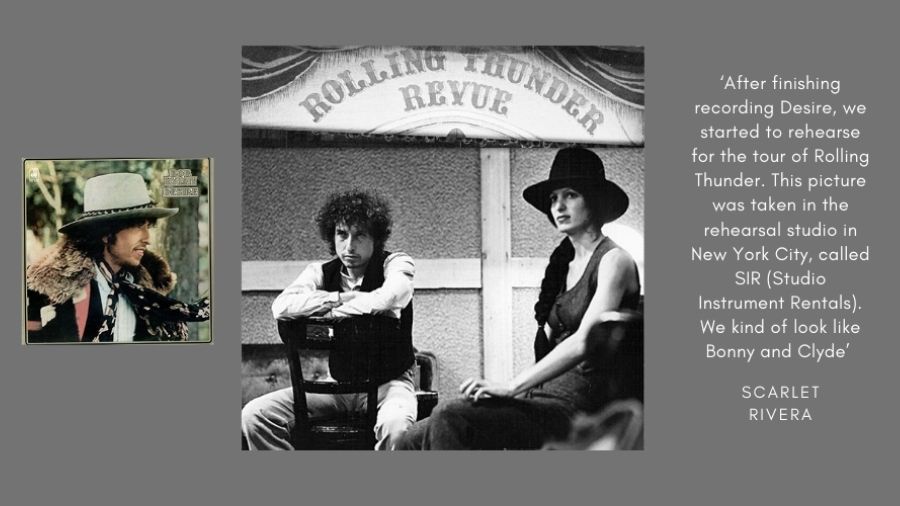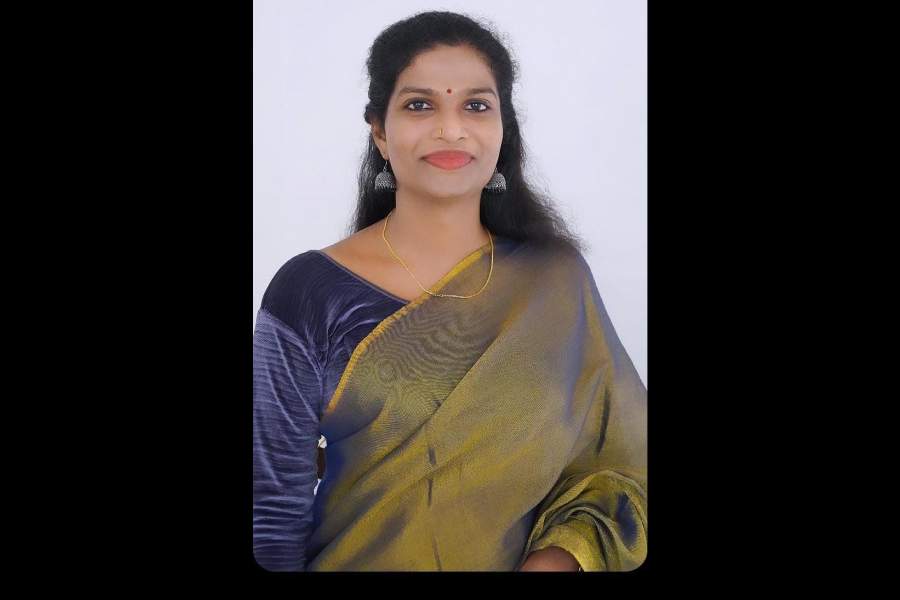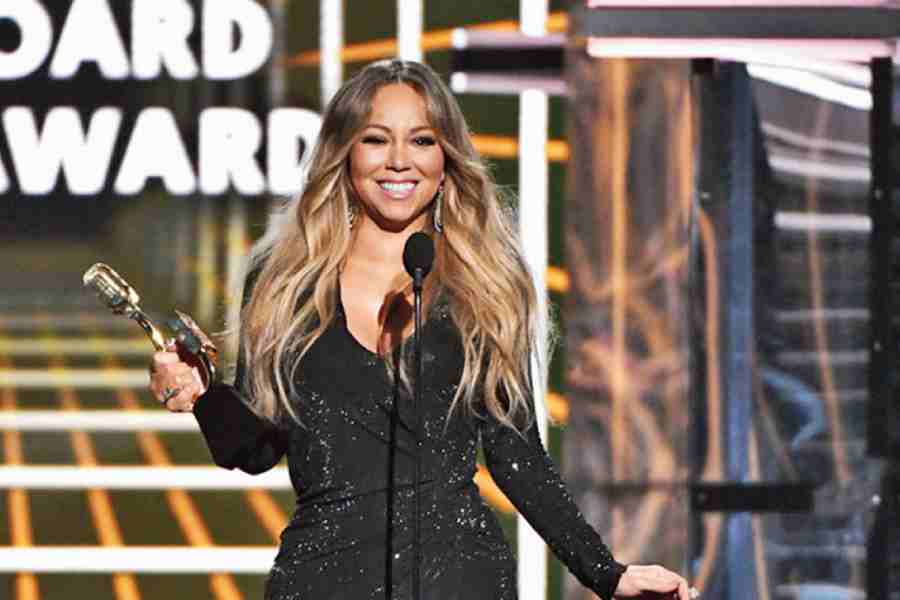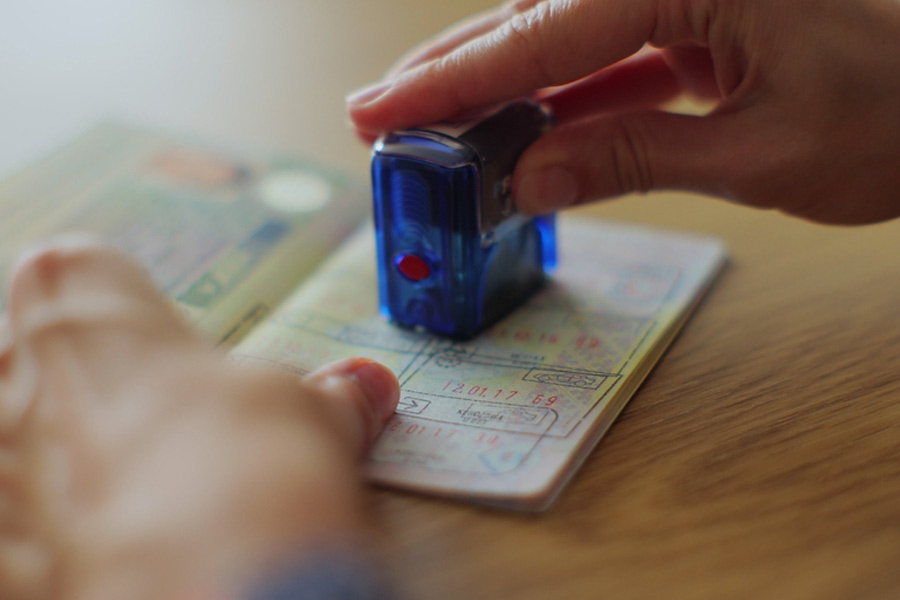You hear hints of her playing just before the foot-tapping urgency and beat-bouncy feel of Hurricane kick in. What is a soft incantation at intro of the first track of Bob Dylan’s album Desire morphs into an emphatically searing solo in the politically charged song about the incarceration of boxer Rubin ‘Hurricane’ Carter, who went on to becoming a telling symbol of the civil rights movement in America. She comes in with equal finesse in the next song, Isis, but this time gently playing over his harmonica. What’s going on? But hey, it works. Wonderful. Listen on. There she is again in Mozambique, coming ever so strongly soon after in One More Cup of Coffee (Valley Below). The mix is heady. The flavour intimate. She is all over the song. Teasing, loving, then suddenly distant; only to sweep down like a bird of prey and then soar into the skies again. By the time we are at Sara, love is a palette of colour. Stark brush strokes, she is now playing over his harmonica. Loud. Clear. She has pierced your soul. In a nice way.
Nobody knew Scarlet Rivera up until then. “I believe I opened the door for many other violin/string players who hear and do things differently,” she says about her unlikely foray into rock stardom four decades earlier. A shy, rebellious girl, who thought nothing of being thrown out of an orchestra for playing a prank on her conductor, she used to be a deeply private person only willing to give herself to music. It’s a miracle her path crossed, literally, with that of Bob Dylan. Today, 45 years after the bestselling Desire was recorded, Scarlet confirms what is now part rock legend, albeit with some crucial amendments _ Dylan did not smile, talk or do anything to indicate approval the first time she played for him, that came hours later on that eventful day when he took her to a Muddy Waters concert; prior to her ultimately joining the band, recording for Desire had already begun; the band that was helping Dylan cut the album, which included a guitar superstar, was asked to leave after her place was sealed; and that she was the first to use paint on her forehead during the Rolling Thunder tour that Dylan launched soon after wrapping up recording Desire, and, therefore, may have been the catalyst that got him to smear white paint on his face with dark eyeliners during the show _ she doesn’t even mention the Kiss concert which she purportedly took Dylan to from which he is said to have got the idea.

Scarlet Rivera, sometime in February 2020. Picture courtesy: Scarlet Rivera website
“It was written in the stars that we should meet,” she tells The Telegraph Online in an exclusive and expansive conversation over Zoom from her apartment in Los Angeles over a fortnight ago. “I think it would take a whole chapter to really describe it, because, what happened in my life and what made me who I was at the time is the reason why that date with destiny happened.”
Hence, first things first. We know she, then in her mid-20s, was on way to rehearsal in East Village, New York City, with violin case in hand when the miracle unfolded. “As I was walking down the street towards that apartment, I sensed a car was trailing me. And then, at some point, I was about to cross the street, it cut me off, and he insisted that we talk. He wanted to know about my playing, and if I could play. I said, ‘well, you know, I have a rehearsal I have to go’. And he said, ‘forget that rehearsal’. But he engaged me in more conversation, and finally talked me into getting into the car,” recalls Scarlet, noting that the depth of the conversation made her realise the man in the car wasn’t a Bob Dylan lookalike. “This was the real thing,” she laughs.
Then, in that apartment full of musical instruments, Dylan used the piano and guitar to play for her “obscure songs” and asked her to play along. No chart, no key, nothing. And Scarlet played along, realising only much later that it was a “sink or swim situation”. He was kind of deadpan, playing song after song as she wielded her bow. Then, suddenly, he asked her if she would accompany him to a Muddy Waters show about to happen in the neighbourhood. Oh, to be in New York City.
Scarlet tagged along. No brainer. Dylan sat her down on a bar stool with a drink and went off, only to appear on stage alongside Muddy. “The place went absolutely bananas. Then he went to the microphone, and to the shock of my life, said, ‘now I want my violinist to come up and play’,” she says with relish about the moment she realised for the first time that she was the chosen one. “Then I got the chance to play with the Muddy Waters Band, and I got a solo from Muddy Waters… then the whole band stared at me, and little by little, each one smiled. I got a thumbs up from Bob Dylan and Muddy Waters on the same day.”
Then about a week later, Scarlet got a call from Dylan, asking her to show up at CBS studios, where upon arrival she saw a host of musicians, but didn’t really get to interact with them as she had to play from an isolation booth to prevent sound leakage. Days later she realised that most of the band members were gone, leaving her and a trio of musicians including bassist Rob Stoner and drummer Howard Wyeth. She was then completely oblivious of the fact that they would, in fact, be re-recording/overdubbing what was to be released a year later in 1976 as the album Desire even though some of it had already been recorded by Dylan using top sessions musicians of New York and Eric Clapton and his band. “The reality of it didn’t sink in actually for years. It happened really quickly. But it was a very long day. When the red light wasn’t on and we weren’t recording but rehearsing the next song with everybody, I got to see Clapton in the room and play at the same time. Then, I get a little bit of feedback from Bob. At one point I was playing his song, and he started to play harmonica, and I stopped playing. He stopped the song and said, ‘I actually want you to play over my harmonica and see what happens’.”

Scarlet ‘Queen of Swords’ Rivera. Picture courtesy: Scarlet Rivera website
They all went home at dawn after a tiring day of recording. But when Scarlet returned to the studio, she saw that Clapton and his band had gone. All the sessions players were gone. “It was like the ‘Showdown at the OK Corral’. I was the one that was left standing in the room,” she says.
We hear Scarlet in full flow in the album of course, but more so in the concerts played during Dylan’s Rolling Thunder tour, footage of which has been patched together delightfully _ annoyingly, some might add _ by Martin Scorsese as a montage of fictional interludes to the carnivalesque excesses of the performances in the Netflix rockumentary, Rolling Thunder Revue. Her face adorned with line drawings, she stands tall to the right of Dylan, playing alongside and over his incessant vocals, frenetic guitar and incisive harmonica. Quite an accomplishment, a marquee moment no doubt within the evolving aesthetics of rock music of the mid-70s. “I also found out later that many people have tried to play over his harmonica but that didn’t work. I guess, I am one of the few people that has successfully played while he’s playing at the same time,” she concurs. The Rolling Thunder tour had an eclectic star cast of musicians, poets, and playwrights. From Roger McGuinn, Joan Baez and Joni Mitchell to poet Allen Ginsberg and Sam Shepard, in addition to Dylan’s band that included T Bone Burnett. It was fun, but a musical highpoint of monumental proportions. “When somebody’s wearing a mask, he’s going to tell the truth. When he’s not wearing a mask, it’s highly unlikely,” Dylan says in the film when he’s not wearing one.
The songs they played during the tour were rehearsed, as Scarlet recalls, while commenting on a picture of Dylan and her sitting together like “Bonny and Clyde”. But the performances were wrapped in the brilliance of spontaneity. The versions varied, changing tempo and mood from energetic to contemplative night after night. Compare One More Cup of Coffee of Desire to the live version and the magic is evident. “I was on stage with Roger McGuinn and Joni Mitchell. The level of musicianship around me was mind blowing,” is how Scarlet describes the tour of 31 concerts spanning 40 days across 23 cities. “It was a magical experience on stage and off. And Bob’s level of performance and singing at that period was just on fire.”
The atmosphere was nothing like Scarlet had ever experienced. Dylan, she explains, wanted to do this for the sake of music and for the spirit of camaraderie it generates when like-minded artistes play together. “I feel that Bob Dylan could have easily been playing at larger venues of, say, 10,000-seat capacity. He could have done this to make money. But he really wanted to do this for the audience. He chose smaller places. The business guys were tearing out their hair… He brought many more people on. And on days off he would create opportunities for us to do unusual things together sometimes.”
In the Scorsese film, Scarlet explains the atmosphere of the tour as the “Tambourine Man” allowing them the “freedom to be who we want to be.” No wonder she felt compelled to give flight to her inner voice at the time. “I was guided by, I believe, a muse. I was the first person on Day One to do face paint,” she says. “I had, I think, a diamond with a little sword and a little snake, and something on my chest as well. But it wasn’t about me trying to come up with a gimmick. Nor did I do it every day. It was just when I felt called to do it. But any band member that did it (and many of them did) subsequent to him doing the white face was just copycatting.”
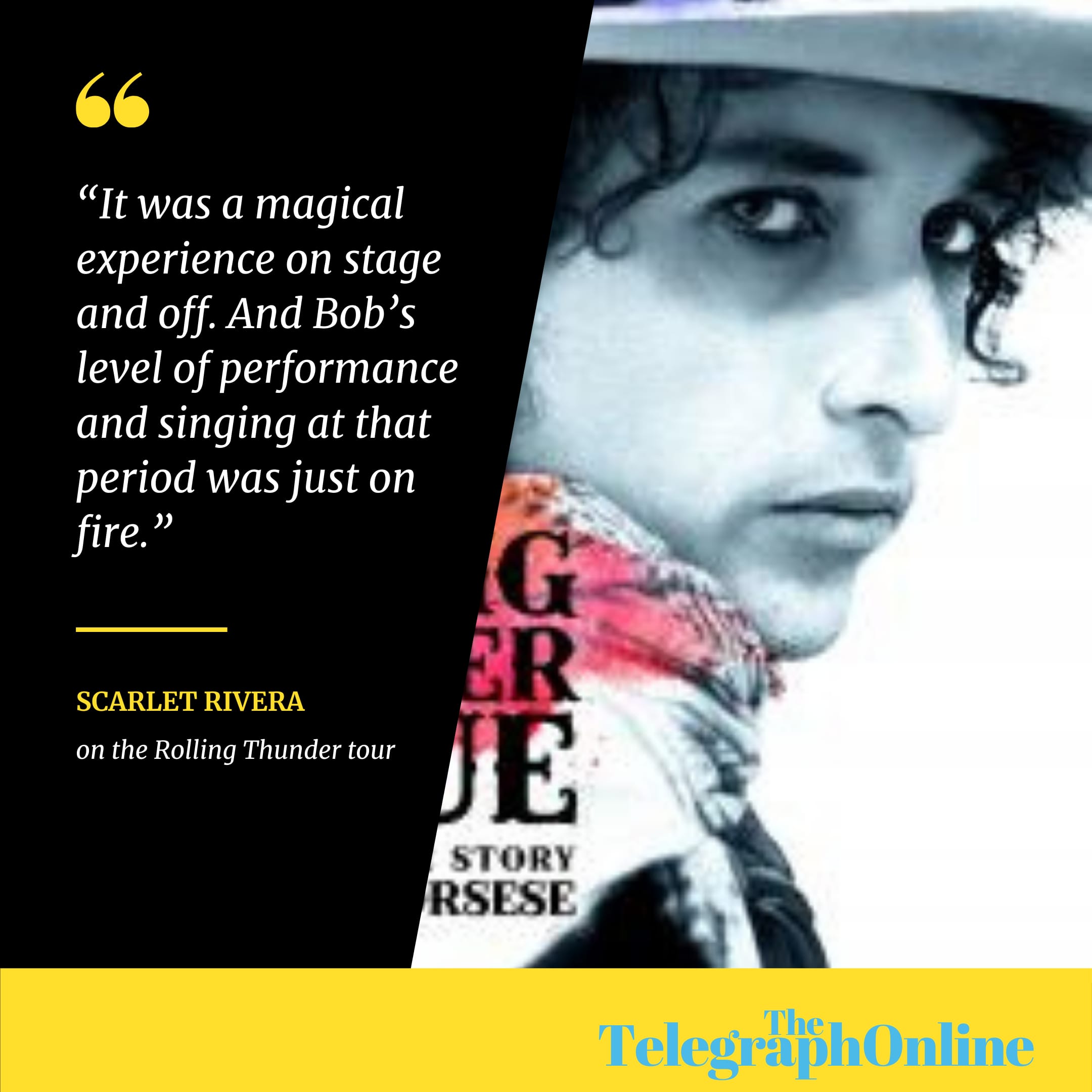
Graphic: The Telegraph Online
Scarlet remembers a band meeting at the end of the tour with Dylan asking each one of them about their future plans. “I think nobody really wanted it to end. And this was such a unique combination of people at that time. It was sad, a kind of depressing period,” she says, calling it her Cinderella moment of having to move back home. “I went back to New York City and then people started calling me for recording sessions. One of the first ones that came was from the leader of the New York Dolls, David Johansson. Then all kinds of recording sessions came in and I got back to violin lessons.” Decades later, it is clear to her how because of that miraculous meeting with Dylan, and her subsequent playing with him, she has been able to do with the violin what she had always hoped to.
Classically trained via private lessons from the time she was six or seven, Scarlet spent a year in orchestra and then moved to Mannes conservatory (The New School Mannes) in New York. But as a teenager, she had displayed a rebellious streak and got expelled from an orchestra for purposely spreading confusion about a piece they were to perform. “When the conductor was out of the room, I told everybody to ask for the Beethoven (piece) when we were going to play the Mozart. And he was so mad that he broke his baton over my stand and told me to get out. From that point on, I was determined to integrate the violin into contemporary music and not just the music of hundreds of years ago,” she says.
Scarlet wanted to find a living voice for the violin, and not just as a “sweetener”, the way Sinatra or Roy Orbison and Johnny Mathis used it. There was no such thing as a rock violin soloist. But after Rolling Thunder, she had established herself as one. If the improvisation of the kind she did with Dylan seems natural, it’s because of her varied taste in music. “Since high school and college, I was listening a lot even though I was in an orchestra and reading music and taking lessons. On the side, I was listening deeply to the Doors, John Mayall and the Blues Breakers, John Lee Hooker, Janis Joplin, Tangerine Dreams, King Crimson… They were just exciting to me.”
That seems to have worked. Her collaborations with the likes of Mercer Ellington (the Duke’s son), Eric Anderson and Tracy Chapman speak for themselves. Last April, she launched an album, her 12th. All of Me is an EP of six songs in which she is singing, for the first time, about democracy, bad money and the agonising lack of common sense. Dust Bowl best exemplifies her “deep-seeded smouldering vocals” notes American Highways, an independent web magazine of American music. Songbird is a tribute to her friend Joni Mitchell.
Today, says Scarlet, it’s not just the violin that has gone mainstream. “It’s spread to all the strings like, say, cello. Also, synth strings have replaced violin a lot in other things as well _ of course you can’t really replace the real sound though you can imitate it. But I believe I opened the door for many other violin/string players who hear and do things differently,” she says, adding how a critic spoke of her playing as the “emotional counterpoint to Jean Luc Ponty” when I bring up the French violinist’s pioneering endeavours in jazz rock.
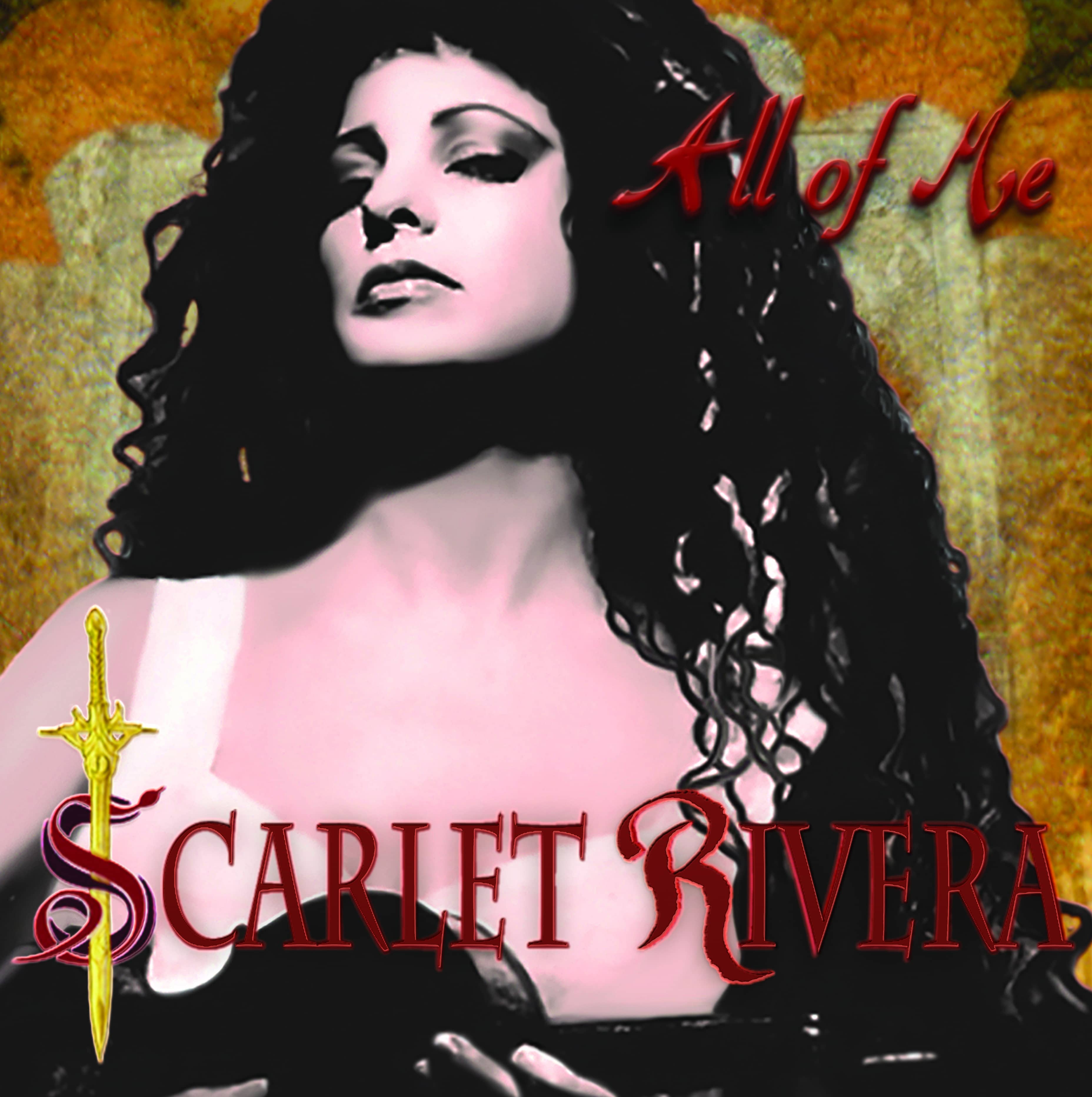
Her latest album. Picture courtesy: Scarlet Rivera website
Yet, Scarlet has never allowed herself to move away from the core. “I stayed with classical music too,” she notes, going on to talk about future projects that include an album of her Celtic compositions and another compilation of her jazz-rock pieces. Additionally, she is part of an ambitious world music project that is intended, as audio and video, to highlight scientific statistics on the perils of climate change and biodiversity. “The music will live on,” she says, her beloved muse continuing to guide her the way it did decades ago when she was crossing that road in the East Village of NYC. A moment earlier, or later, who knows? Bob Dylan’s car would have missed her, never to find her again.
Scarlet listens to Desire often. “I still really like listening to Oh, Sister and Isis. I wish Abandoned Love was included in place of Joey. And I still listen to some live tracks as well, you know, from our live shows,” she says affectionately. The memories are treasured; most of all about how protective Dylan was of her during the tour. “He knew that I was just as green as an apple. I’d never been on a stage before that day, and I had never been around so many people. I was extremely shy. There were a lot of people around us with the band guys doing drugs and what not. You know, people can be mean, and there were jealous women around… he just knew that I was going to be the target of a lot of things that I was innocent about. And so, he just kept an eye out,” she says, convinced that her very nature of being “an anti-social activist and intense musician” was the precursor of why she and him would have been a good fit.
She hasn’t met Dylan in the last few years but has seen him often on and off stage in New York and Minneapolis, his hometown. Just after Rolling Thunder she went to a concert of his sometime in the ’80s with a common friend from Minneapolis who was visiting. It was a very small place and it was sold out. They were called in and invited to the dressing room. And just before the band was going on stage, and before Scarlet and the friend could walk out to their seats, she heard Dylan telling his musical director, ‘please add One More Cup of Coffee to the set’.
Your breath is sweet, your eyes are like
Two jewels in the sky
Your back is straight, your hair is smooth
On the pillow where you lie
One more cup of coffee for the road
One more cup of coffee 'fore I go
To the valley below

